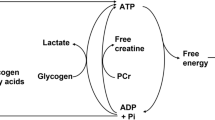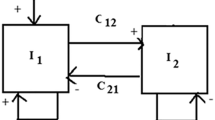Abstract
A nonlinear mathematical model of the CO2 control system was used to examine a number of issues concerning the regulation of PaCO2 during rest and exercise. To gain insight to the regulatory properties of the respiratory system, the open loop gain (Gl) and closed loop sensitivities Si=ξPaCO2/ξPiCO2 and\(Sv = \partial PaCO_2 /\partial \dot Vco_2\) were calculated. Gl indicates the ability of a control system to regulate the controlled variable, PaCO2 in the model. Si and Sv represent the change in PaCO2 to unit changes in PiCO2 and\(\dot Vco_2\), respectively. Model predications were obtained for rest and various intensities of exercise for the following challenges to the respiratory system: (a) CO2 inhalation, (b) i.v. CO2 loading, (c) application of an external dead space, and (d) a shift in the resting operating point. Increasing exercise intensity produced a substantial decrease in Gl and increase in Si consistent with the hypothesis that exercise degrades the ability of the respiratory system to regulate PaCO2. However, Sv decreased indicating that the respiratory system would actually be better able to regulate PaCO2 if there were fluctuations in\(\dot Vco_2\). Thus, Gl does not completely describe the regulatory characteristics of the respiratory control system. It is demonstrated that the regulatory characteristics of the respiratory system as described by Gl, Si, and Sv are complex and depend on the nature of the challenge. Techniques for systematically describing the regulatory properties of the CO2 control system are described.
Similar content being viewed by others
References
Bennett, F.M.; Tallman, R.D.; Grodins, F.S. Role of\(\dot VCO_2\) in control of breathing of awake exercising dogs. J. Appl. Physiol. 56:1335–1337; 1984.
Bennett, F.M.; Fordyce, W.E. Characteristics of the ventilatory exercise stimulus. Respir. Physiol. 59:55–63; 1985.
Bennett, F.M.; Fordyce, W.E. Gain of the ventilatory exercise stimulus: Definition and meaning. J. Appl. Physiol. 65:2011–2017; 1988.
Clark, J.M.; Sinclair, R.D.; Lenox, J.B. Chemical and nonchemical components of ventilation during hypercapnic exercise in man. J. Appl. Physiol. 48:1065–1076; 1980.
Coggan, A.R.; Coyle, E.F. Effect of carbohydrate feeding during high-intensity exercise. J. Appl. Physiol. 65:1703–1709; 1988.
Dempsey, J.A.; Vidruk, E.H.; Mitchell, G.S. Pulmonary control systems in exercise. Federation Proc. 44:2260–2270; 1985.
Fordyce, W.E.; Grodins, F.S. Ventilatory response to intravenous and airway CO2 administration in anesthetized dogs. J. Appl. Physiol. 48:337–346; 1980.
Fordyce, W.E.; Kanter, R.K. Arterial-end tidal PCO2 equilibrium in the cat during acute hypercapnia. Resp. Physiol. 73:257–272; 1988.
Gray, J.S.; Grodins, F.S.; Carter, E.T. Alveolar and total ventilation and the dead space problem. J. Appl. Physiol. 9:307–320; 1956.
Greco, E.C.; Fordyce, W.E.; Gonzalez, F.; Reischl, P.; Grodins, F.S. Respiratory responses to intravenous and intrapulmonary CO2 in awake dogs. J. Appl. Physiol. 45: 109–114; 1978.
Grodins, F.S. Analysis of factors concerned in regulation of breathing in exercise. Physiol. Rev. 30:220–239; 1950.
Grodins, F.S. Control theory and biological systems. New York: Columbia University Press; 1963.
Grodins, F.S.; Gray, J.S.; Schroeder, K.R.; Norins, A.L.; Jones, R.W. Respiratory responses to CO2 inhalation. A theoretical study of a non-linear biological regulator. J. Appl. Physiol. 7:283–308; 1954.
Honda, Y.; Hayashi, F.; Yoshida, A.; Ohyabu, Y.; Nishibayashi, Y.; Kimura, Y. Overall “gain” of the respiratory control system in normoxic humans awake and asleep. J. Appl. Physiol. 55:1530–1535, 1983.
Loescheke, H.H. The effectiveness of the control of pH in the extracellular fluid of the brain by the respiratory control system. Pflugers Arch. 341:43–50; 1974.
Masuyama, H.; Honda, Y. Differences in overall “gain” of CO2-feedback system between dead space and CO2 ventilation in man. Bull. Eur. Physiopathol. Respir. 20:501–506; 1984.
Milhorn, Jr., H.T. The application of control theory to physiological systems. Philadelphia: Saunders; 1966.
Milhorn, H.T.; Guyton, A.C. An analog computer analysis of Cheynes-Stokes breathing. J. Appl. Physiol. 20:328–333; 1965.
Mitchell, G.S.; Smith, C.A.; Dempsey, J.A. Changes in the\(\dot VI - \dot VCO_2\) relationship during exercise in goats: role of carotid bodies. J. Appl. Physiol. 57:1894–1900; 1984.
Mitchell, G.S. Ventilatory control during exercise with increasing respiratory dead space in goats. J. Appl. Physiol. 69:718–727; 1990.
Oren, A.; Wasserman, K.; Davis, J.A.; Whipp, B.J. Effect of CO2 set point on ventilatory response to exercise. J. Appl. Physiol. 51:185–189; 1981.
Pearce, D.H.; Milhorn, Jr., H.T. Dynamics and steady-state respiratory response to bicycle exercise. J. Appl. Physiol. 42:959–967; 1977.
Riggs, D.S. Control theory and physiological feedback mechanisms. Huntington, NY: R.E. Krieger Publishing Co.; 1976.
Stegemann, J.; Seez, P.; Kremer, W.; Boning, D. A mathematical model of the ventilatory control system to carbon dioxide with special reference to athletes and nonathletes. Pflugers Arch. 356:223–236; 1975.
Stremel, R.W.; Huntsman, D.J.; Casaburi, R.; Whipp, B.J.; Wasserman, K. Control of ventilation during intravenous CO2 loading in the awake dog. J. Appl. Physiol. 44:311–316; 1978.
Ward, S.A.; Whipp, B.J. Ventilatory control during exercise with increased external dead space. J. Appl. Physiol. 48:225–231; 1980.
Wasserman, K.; Whipp, B.J.; Casaburi, R. Respiratory control during exercise. In: Handbook of physiology. The respiratory system. Control of breathing. Sect. 3, vol II, part 2, chapter 17. Bethesda, MD: Am. Physiol. Soc., 1986: pp. 595–620.
Takano, N.; Sakai, A.; Iida, Y. Analysis of alveolar PCO2 during the menstrual cycle. Pflugers Arch. 390:56–62, 1981.
Author information
Authors and Affiliations
Rights and permissions
About this article
Cite this article
Bennett, F.M., Fordyce, W.E. Regulation of PaCO2 during rest and exercise: A modeling study. Ann Biomed Eng 21, 545–555 (1993). https://doi.org/10.1007/BF02584337
Issue Date:
DOI: https://doi.org/10.1007/BF02584337




